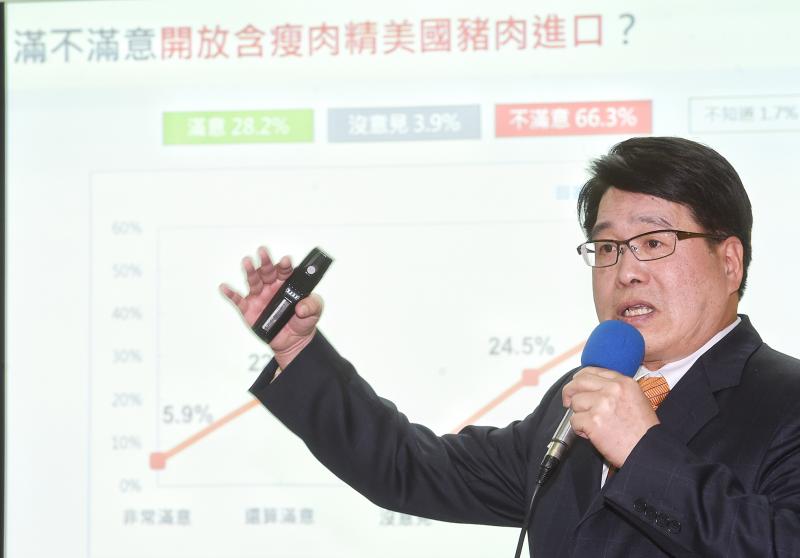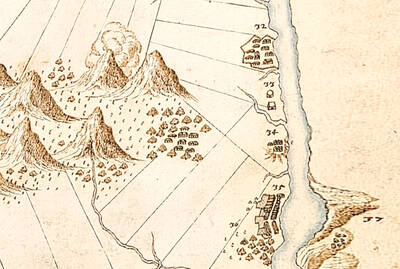It’s a day ending in -y in Taiwan, so we all know what President Tsai Ing-wen’s (蔡英文) satisfaction ratings must be doing: falling. Is that I Got You Babe playing on the radio?
Another round of polls has triggered a furious outbreak of stenography in the local and international media. The Taiwanese Public Opinion Foundation (TPOF) brought out a poll at the end of May which had Tsai’s satisfaction ratings hitting a 21-month low of 45.7 percent. This finding and its framing were widely reported in the media.
Foundation Chairman Michael You (游盈隆) said that such a large change — an 8.7 percent drop — in a short time was rare, but a glance back through the TPOF’s own polls shows such “large” changes are common.

Photo: Liu Hsin-de, Taipei Times
For example, in May of 2019, TPOF released a poll showing Tsai’s approval ratings had risen 8.5 percent in a month. Similarly in June of last year Tsai’s approval rating fell 8.9 percent, driven down by public dissatisfaction with the COVID-19 stimulus. A TPOF poll in September last year had Tsai’s approval falling over 11 percent.
Rapid changes reflect the public’s response to whatever issue has seized the public’s attention, and are hardly abnormal.
What is normal about the TPOF poll was its framing. In its presentation of TPOF polls, both foreign and local media typically omit mention of You’s longstanding beef with Tsai, and his support of presidential candidate William Lai (賴清德), who is currently vice president, in the Democratic Progressive Party’s (DPP) primary before last year’s election.
You’s animus towards Tsai may not affect the numbers, but it does appear to affect the framing of TPOF presentations. The TPOF described the May poll number as a “21-month low,” but the Foundation had Tsai at 56 percent in October, 52 percent in December, and 51 percent in January.
This of course did not stop You from framing the numbers as a “serious alarm bell,” a framing that the foreign media dutifully reproduced, instead of challenging or contextualizing.
In other words, TPOF’s own numbers show that this “low” is in reality a gentle slide of 10 percent in the last 9 months and that the month-to-month variation is entirely unremarkable.
Of course, “entirely unremarkable” doesn’t make good news copy. Nor does TPOF’s polling record, which in May of 2019 had Lai beating Tsai by 12 points in the primary (she won by roughly 8 points) and Lai doing much better against Chinese Nationalist Party (KMT) presidential candidate Han Kuo-yu (韓國瑜) than Tsai.
In 2017, when Tsai’s approval rating dipped below 30 percent, and Taipei Mayor Ko Wen-je’s (柯文哲) approval exceeded 68 percent, Chairman You described Ko as a “Godzilla,” saying: “In the history of Taiwan, only one person had a similar level of popularity: James Soong (宋楚瑜).”
Soong would go on to lose in presidential elections more often than any major politician in Taiwanese history.
Meanwhile Tsai hit that level, twice, after the elections in 2016 and last year, as did Lai right after he became premier, in a Taiwan NextGen Foundation poll. Ko’s popularity, by contrast, has been … transient.
After the DPP’s loss in the 2018 local elections, You framed the results of the TPOF’s latest poll in which Tsai’s approval had fallen to 24.3 percent as showing that “the KMT has fully recovered from its bruising defeat in the 2016 elections, while the DPP has slid back to where it was 10 years ago.”
Tsai’s 24.3 percent? As transient as Ko’s popularity. Two years later the “slide back a decade” DPP under Tsai would crush Han in the presidential election and retain control of the legislature. Readers should keep that low number in mind whenever they reflect on Tsai’s current approval levels and the tiresome, antidemocratic glee with which the domestic and international media negatively reports on them.
The polls also vary widely. A February poll by My-Formosa.com, which is usually described as green-leaning in the media, had Tsai at 59 percent. A poll from Blue-leaning TVBS released last month had Tsai at 41 percent.
Simple truth: nothing out of the ordinary is happening. Tsai, like Ma Ying-jeou (馬英九) before her, and Chen Shui-bian (陳水扁) before Ma, started out with high poll ratings, which over the next few months of their administrations fell to more reasonable numbers, then slowly fell from there.
Everyone seems to have forgotten that by September of 2008, not even half a year after his first inauguration, in a Global Views Monthly survey, Ma hit 24.9 percent. That was a year before his disastrous performance during Typhoon Morakot.
Contextualization of these numbers is desperately needed, and will be assiduously neglected by both local and international media. The simple truth is that the Tsai administration’s poll numbers are miraculous compared to the Ma administration’s.
In 2014, after the Sunflower Movement and numerous other issues, then-Premier Jiang Yi-huah’s (江宜樺) ratings fell to 16.4 percent by December, according to Commonwealth Magazine. In 2010, the magazine also wrote that then-premier Wu Den-yih (吳敦義) had hit 36 percent, while Ma’s premier in 2009 (go ahead, see if you can remember his name) had satisfaction ratings of 27.9 percent.
These are normal numbers for premiers: Tsai’s first premier, Lin Chuan (林全) went out with a 25.9 percent rating in 2017, according to Commonwealth Magazine. Being premier is a thankless task.
The numbers above happened without a long drought, electric power supply troubles and a COVID-19 outbreak.
The recent TPOF poll trumpeting Tsai’s “21-month low” had approval for Premier Su Tseng-chang (蘇貞昌) falling 9.5 percent to around 45 percent. What was the Su cabinet’s satisfaction in March of 2019, according to TPOF? 48 percent.
The TPOF poll that had Tsai at a “21-month low” also had over three-fourths of adults rating the performance of the Central Epidemic Command Center (CECC) at 60 or above on a 0-100 scale, with only 18.9 percent rating it below 60.
In other words, the tale told by these numbers is not one of poll numbers that have “plummeted” or experienced a “sudden drop” as major international papers described it this month.
It is a story of an administration, which despite the usual abuses from China, the ractopork decision, drought, electric power struggles and a year mired in COVID-19 problems, from financial and aid issues to a dangerous outbreak, has managed to maintain ratings in the polls its predecessor administrations can only view with envy.
It is highly likely that Tsai’s poll numbers will continue to decline. COVID-19 case numbers are slowly falling at the moment, implying that there is some possibility the level 3 restrictions may be extended. President Tsai will take the hit for that. The reservoirs got a big boost from the rain this month, which won’t help her much because the public will perceive it as returning to normality.
The one thing we can count on, though, is that the local and international media will continue to report with glee on her perpetually falling poll numbers. I’ll turn over to smash that radio now.
Notes from Central Taiwan is a column written by long-term resident Michael Turton, who provides incisive commentary informed by three decades of living in and writing about his adoptive country. The views expressed here are his own.

The Nuremberg trials have inspired filmmakers before, from Stanley Kramer’s 1961 drama to the 2000 television miniseries with Alec Baldwin and Brian Cox. But for the latest take, Nuremberg, writer-director James Vanderbilt focuses on a lesser-known figure: The US Army psychiatrist Douglas Kelley, who after the war was assigned to supervise and evaluate captured Nazi leaders to ensure they were fit for trial (and also keep them alive). But his is a name that had been largely forgotten: He wasn’t even a character in the miniseries. Kelley, portrayed in the film by Rami Malek, was an ambitious sort who saw in

It’s always a pleasure to see something one has long advocated slowly become reality. The late August visit of a delegation to the Philippines led by Deputy Minister of Agriculture Huang Chao-ching (黃昭欽), Chair of Chinese International Economic Cooperation Association Joseph Lyu (呂桔誠) and US-Taiwan Business Council vice president, Lotta Danielsson, was yet another example of how the two nations are drawing closer together. The security threat from the People’s Republic of China (PRC), along with their complementary economies, is finally fostering growth in ties. Interestingly, officials from both sides often refer to a shared Austronesian heritage when arguing for

Among the Nazis who were prosecuted during the Nuremberg trials in 1945 and 1946 was Hitler’s second-in-command, Hermann Goring. Less widely known, though, is the involvement of the US psychiatrist Douglas Kelley, who spent more than 80 hours interviewing and assessing Goring and 21 other Nazi officials prior to the trials. As described in Jack El-Hai’s 2013 book The Nazi and the Psychiatrist, Kelley was charmed by Goring but also haunted by his own conclusion that the Nazis’ atrocities were not specific to that time and place or to those people: they could in fact happen anywhere. He was ultimately

Nov. 17 to Nov. 23 When Kanori Ino surveyed Taipei’s Indigenous settlements in 1896, he found a culture that was fading. Although there was still a “clear line of distinction” between the Ketagalan people and the neighboring Han settlers that had been arriving over the previous 200 years, the former had largely adopted the customs and language of the latter. “Fortunately, some elders still remember their past customs and language. But if we do not hurry and record them now, future researchers will have nothing left but to weep amid the ruins of Indigenous settlements,” he wrote in the Journal of